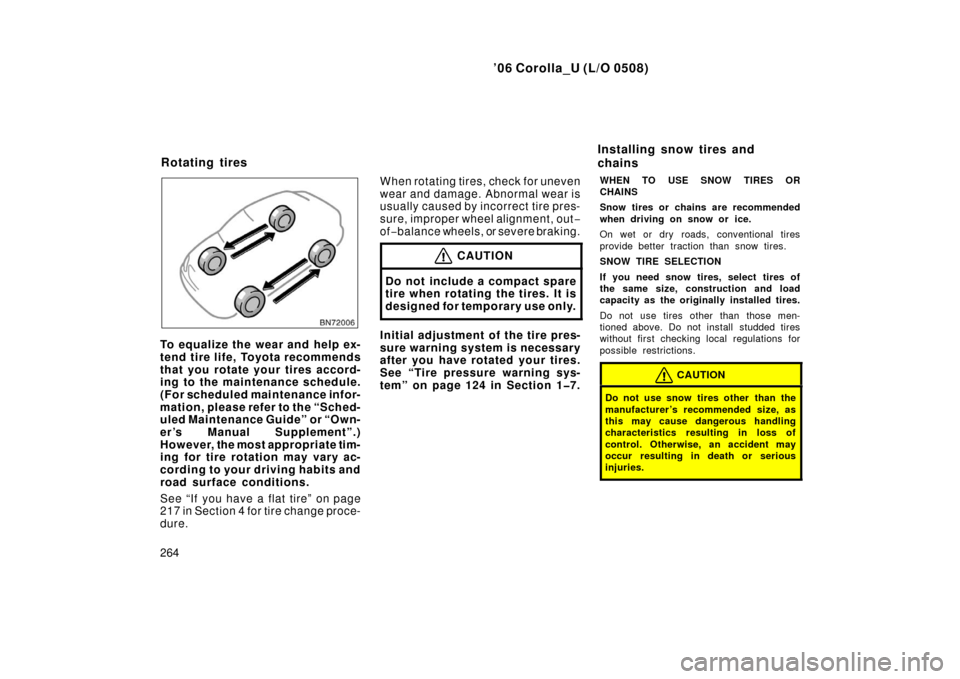Page 274 of 302

’06 Corolla_U (L/O 0508)
264
To equalize the wear and help ex-
tend tire life, Toyota recommends
that you rotate your tires accord-
ing to the maintenance schedule.
(For scheduled maintenance infor-
mation, please refer to the “Sched-
uled Maintenance Guide” or “Own-
er’s Manual Supplement”.)
However, the most appropriate tim-
ing for tire rotation may vary ac-
cording to your driving habits and
road surface conditions.
See “If you have a flat tire” on page
217 in Section 4 for tire change proce-
dure.When rotating tires, check for uneven
wear and damage. Abnormal wear is
usually caused by incorrect tire pres-
sure, improper wheel alignment, out
−
of −balance wheels, or severe braking.
CAUTION
Do not include a compact spare
tire when rotating the tires. It is
designed for temporary use only.
Initial adjustment of the tire pres-
sure warning system is necessary
after you have rotated your tires.
See “Tire pressure warning sys-
tem” on page 124 in Section 1�7.
WHEN TO USE SNOW TIRES OR
CHAINS
Snow tires or chains are recommended
when driving on snow or ice.
On wet or dry roads, conventional tires
provide better traction than snow tires.
SNOW TIRE SELECTION
If you need snow tires, select tires of
the same size, construction and load
capacity as the originally installed tires.
Do not use tires other than those men-
tioned above. Do not install studded tires
without first checking local regulations for
possible restrictions.
CAUTION
Do not use snow tires other than the
manufacturer ’s recommended size, as
this may cause dangerous handling
characteristics resulting in loss of
control. Otherwise, an accident may
occur resulting in death or serious
injuries.
Rotating tires Installing snow tires and
chains
Page 276 of 302

’06 Corolla_U (L/O 0508)
266
WHEN TO REPLACE YOUR WHEELS
If you have wheel damage such as
bending, cracks or heavy corrosion, the
wheel should be replaced.
If you fail to replace a damaged wheel,
the tire may slip off the wheel or cause
loss of handling control.
WHEEL SELECTION
When replacing wheels, care should be
taken to ensure that the wheels are re-
placed by ones with the same load ca-
pacity, diameter, rim width, and offset.
This must be observed on compact spare
tire, too.
Correct replacement wheels are available
at your Toyota dealer.
A wheel of a different size or type may
adversely affect handling, wheel and bear-
ing life, brake cooling, speedometer/odom-
eter calibration, stopping ability, headlight
aim, bumper height, vehicle ground clear-
ance, and tire or snow chain clearance to
the body and chassis.Replacement with used wheels is not rec-
ommended as they may have been sub-
jected to rough treatment or high mileage
and could fail without warning. Also, bent
wheels which have been straightened may
have structural damage and therefore
should not be used. Never use an inner
tube in a leaking wheel which is designed
for a tubeless tire.
CAUTION
Do not use wheels other than the
manufacturer ’s recommended size, as
this may cause dangerous handling
characteristics resulting in loss of
control. Otherwise, an accident may
occur resulting in death or serious
injuries.
Initial adjustment of the tire pressure
warning system is necessary after you
have replaced your wheels. See “Tire
pressure warning system” on page 124
in Section 1�7.
�When installing aluminum wheels,
check that the wheel nuts are tight
after driving your vehicle the first 1600
km (1000 miles).
�If you have rotated, repaired, or
changed your tires, check that the
wheel nuts are still tight after driving
1600 km (1000 miles).
�When using tire chains, be careful not
to damage the aluminum wheels.
�Use only Toyota wheel nuts and
wrench designed for your aluminum
wheels.
�When balancing your wheels, use only
Toyota balance weights or equivalent
and a plastic or rubber hammer.
�As with any wheel, periodically check
your aluminum wheels for damage. If
damaged, replace immediately.
Replacing wheels
Aluminum wheel precautions
Page 293 of 302

’06 Corolla_U (L/O 0508)
283
AUTOMATIC TRANSAXLE
Fluid capacity (drain and refill),
L (qt., Imp. qt.):Up to 3.0 (3.2, 2.6)
Fluid type: Toyota Genuine ATF Type T −IV
Change automatic transmission fluid only
as necessary.
Generally, it is necessary to change
automatic transmission fluid only if your
vehicle is driven under one of the Special
Operating Conditions listed in your
“Scheduled Maintenance Guide” or
“Owner ’s Manual Supplement”. When
changing the automatic transmission fluid,
use only “Toyota Genuine ATF Type T −IV”
(ATF JWS3309 or NWS6500) to aid in
assuring optimum transaxle performance.
Notice: Using automatic transmission
fluid other than “Toyota Genuine ATF
Type T�IV” may cause deterioration in
shift quality, locking up of your trans-
mission accompanied by vibration, and
ultimately damage the automatic trans-
mission of your vehicle.
Please contact your Toyota dealer for fur-
ther details. BRAKES
Minimum pedal clearance when depressed
with the force of 294 N (30 kgf, 66 lbf)
with the engine running, mm (in.):
With anti −lock brake system 76 (2.99)
Without anti −lock brake system
78 (3.07)
Pedal free play, mm (in.): 1—6 (0.04—0.24)
Pad wear limit, mm (in.): 1.0 (0.04)
Lining wear limit, mm (in.): 1.0 (0.04)
Parking brake adjustment when pulled with
the force of 196 N (20 kgf, 44 lbf): 6—9 clicks
Fluid type: SAE J1703 or FMVSS No.116 DOT 3
STEERING
Wheel free play: Less than 30 mm (1.2 in.)
Power steering fluid type: Automatic transmission fluid DEXRON �II
or III